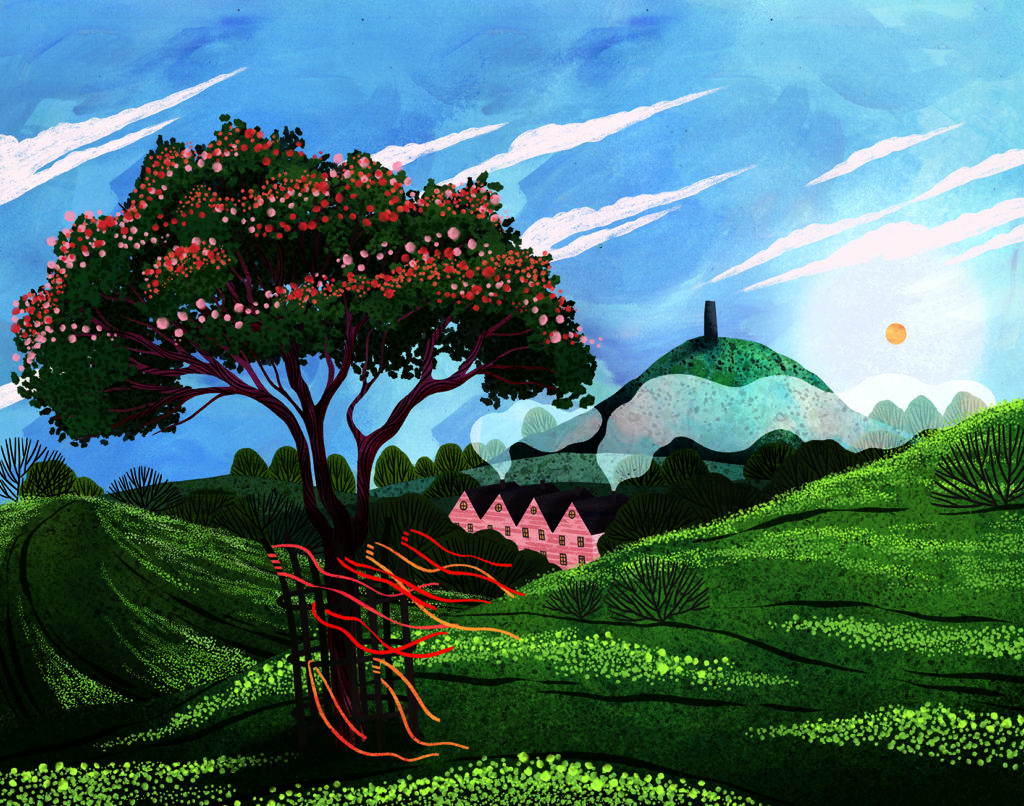An extract from Mark Hooper’s upcoming ‘Great British Tree Biography’, with illustration by Amy Grimes.

Hawthorn, Glastonbury, Somerset, England
The legend of Joseph of Arimathea links the man supposedly responsible for the burial of Jesus with the Holy Grail, Arthurian myth and the small Somerset town of Glastonbury. The tale, as first recorded by French poet Robert de Boron in his poem written c.1200, ‘Joseph d’Arimathe’, holds that the Grail (a drinking vessel that featured in the Last Supper), was used by Joseph to capture the last drops of blood from Christ’s body while he was still on the cross. The story continues with Joseph travelling with the Grail to ‘the valleys of Avaron in the west’, which many have inferred to be Avalon or Glastonbury. Here, the Grail was guarded until the coming of King Arthur.
Before leaving Glastonbury across the flooded Somerset Levels by boat, Joseph is said to have struck the ground on Wearyall Hill with his staff, at which spot a Holy Thorn immediately flowered. Thus the mystery of the Glastonbury Hawthorn is apparently explained. One of very few places where it occurs, this particular hawthorn is a naturally occurring genetic mutation, which differs from common hawthorn in that it flowers twice a year – once in the spring and once on or around Christmas Day. This second flowering over Christmas is seen as a miracle, marking the arrival of Christianity in Britain. Traditionally, the hawthorn is a pagan symbol of fertility that has associations with the May Day and Green Man celebrations in Britain. Thus the idea of a new blossom coinciding with the festivities around Christ’s birth holds profound significance. Glastonbury is the site of one of the most important abbeys in the country, founded as early as the seventh century AD.
Crowds would gather every Christmas Day to witness the holy flowering, but, when Britain adopted the Gregorian calendar in 1752 to bring it in line with the rest of Europe, Christmas fell eleven days earlier, meaning that, much to the consternation of those who congregated on Christmas Day, no flowers appeared. However, when they returned on 5 January, the tree was seen to flower once more, right on cue.
But the Holy Thorn’s legend hasn’t always been appreciated. In the 1640s, during the English Civil War, the original tree was cut down and burned by Cromwell’s troops, who condemned it as a ‘relic of superstition’. Even then, it was recorded that the man who swung his axe at the tree was blinded in one eye by its thorns. A new tree was planted on Wearyall Hill in 1951 on the original site and in 1965 the Queen erected a wooden cross at Glastonbury with the inscription:
‘The cross, the symbol of our faith, the gift of Queen Elizabeth II, marks a Christian sanctuary so ancient that only legend can record its origin.’
The replacement tree had its branches cut off by vandals in 2010 – and its subsequent replacement sapling was further vandalized in 2012. In 2019, the landowner removed the remains entirely.
The story of the Glastonbury Thorn doesn’t end there, however. Since hawthorn is commonly propagated from cuttings or graftings, there are arguably several surviving examples that can be traced back to the original tree. It is believed that the monks at Glastonbury Abbey regularly took cuttings, while in The History and Antiquities of Glastonbury by Charles Eyston (1722), it is stated, ‘There is a person about Glastonbury who has a nursery of them, who, Mr Paschal tells us he is informed, sells them for a crown a piece, or as he can get’. A hawthorn in the grounds of Glastonbury Church as well as the Church of St John were both said to be graftings of Holy Thorn cuttings onto the roots of blackthorn stock – and further cuttings have been exported as far afield as New Zealand, Australia, the USA and Canada.
*
Extracted from ‘The Great British Tree Biography: 50 legendary trees and the tales behind them’, written by Mark Hooper, illustrated by Amy Grimes, and published by Pavilion Books. Out 2 September 2021 – pre-order a copy here (£16.99).